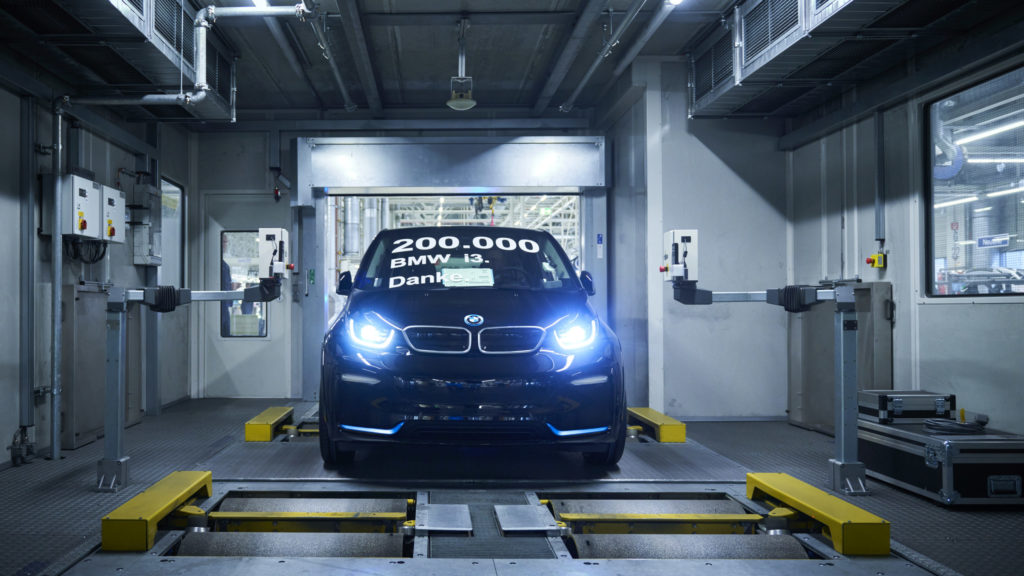It’s been said before, but it bears repeating: it’s hard to believe the i3 has been in production for nearly seven years now, since 2013. Seven years is a long time for any vehicle from any manufacturer to remain in series production, but the i3 isn’t just any vehicle, isn’t it? No matter how you look at it, a vehicle as futuristic, complex, and as specialized as the i3 still being built the better part of a decade after being introduced is incredible. By now, like plenty of other BMWs, the i3 should have been subjected to a refresh (or LCI in BMW speak), and would likely be headed for the veritable pasture or glue factory. Not so with the electric pioneer that is the i3, as it looks to carry on for a few more years of production.
According to BMW, nearly seven years after production commenced, the i3 continues to enjoy strong demand. The consumer appetite for the BMW i3 is so resolute, in fact, that BMW recently ramped up production of its first volume EV at the end of the summer, when the automaker chose to skip a planned manufacturing break to keep the i3 line running. To give full context, choosing to bypass the planned break likely made sense after the novel human coronavirus pandemic interrupted global manufacturing earlier this year, but the fact that the i3 is still selling at all remains something to marvel at.
The i3 owes its longevity to its futuristic modular design, among other factors. Although developing and initially producing the i3 and its high-performance stablemate, the i8, was costly and complex, the ensuring years have yielded strong economies of scale. The i8 may have since bowed out, but BMW is continuing on with the i3, and produced the 200,000th unit on October 15, 2020.
How and why is BMW still producing one of its most complicated models so long after its introduction? There are two important factors to the answer. The first is that, because the i3 and i8 were so involved and costly to produce, BMW chose to go a different route with its follow up models, such as the i4 and iNext, which are slated to debut in the near future. The decision was made a few years ago, when BMW brass opted to use modular platforms shared with other models in series production as the basis for future electrified models. This development signified that there would be no evolutionary successor to either model, and that future BMW EVs will share significantly more in common with their internal combustion-powered stablemates in terms of design and aesthetics.
On the same coin, (this is the second factory) this left BMW without an immediate i3 successor in the pipeline, meaning production of the electro-mobility pioneer would have to continue, at least until more BMW EV models arrive by the 2023 model year. This isn’t a problem for BMW and the i3, because in the years after its introduction, the i3 has become significantly more affordable to manufacture. Painting the plastic exterior panels of an i3 requires 75% less energy and 70% less water than what is used to finish a conventional model. Additionally, 25% of the material used to produce the outer thermoplastic panels is either recycled or renewable, and an impressive portion of the interior also uses raw, renewable materials in its construction as well.
Producing the i3 has also paid dividends for BMW Group Plant Leipzig, where the vast majority of the 200,000 units have been constructed. The production process of the i3 is 100% neutral thanks to onsite wind turbines which provide energy for the manufacturing line, and it takes about half the time to build an i3 in comparison with a conventional BMW model. Technology and other developments first seen on the i3 have also been democratized to other models—the use of carbon-fiber reinforced plastic has since been grafted to the 7 Series, while the knowledge gained from the engineering and advancement of its eDrive system has paved the way for BMW’s fifth-generation electric motor design. Finally, building the i3 wouldn’t be possible without its semi-modular design, which has allowed for perpetually increasing range and capability as battery tech has improved.—Alex Tock
[Photos courtesy BMW AG.]
